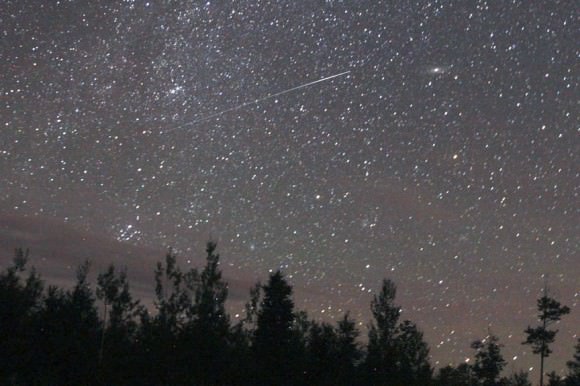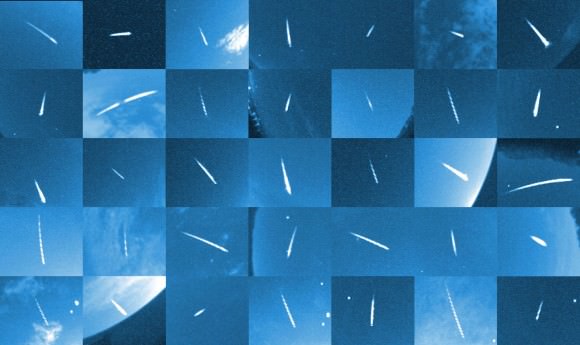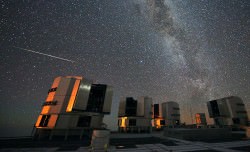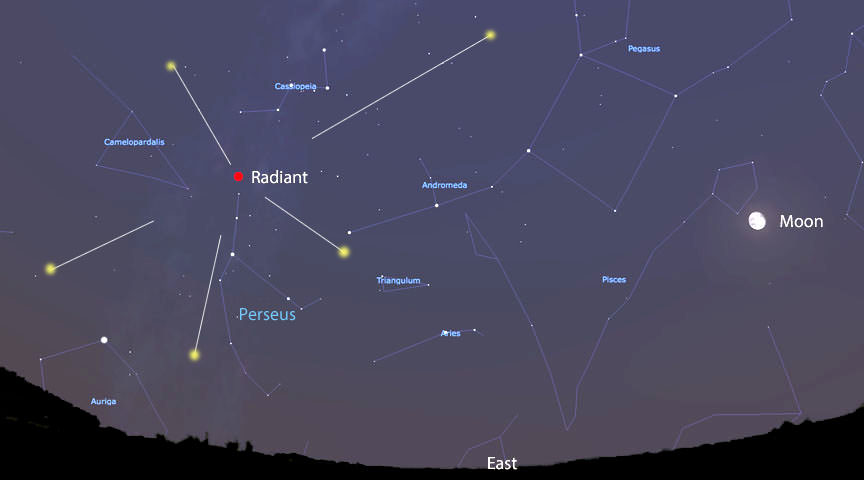Get ready for the darling of meteor showers this week — the Perseids. Who can deny their appeal? Not only is the shower rich with fiery flashes of meteoric light, but the meteors come in August when the weather’s couldn’t be more ideal. Peak activity is expected Tuesday night, Aug. 12-13, when up to 100 meteors an hour might be seen.
Ah, but there’s a rub. This year the moon will be only two days past full and radiant enough to drown out the fainter shower members. We’re more likely to see something like 30 meteors an hour, maybe fewer. But all it takes is one bright meteoric flash to make it all worthwhile. Nothing gets the heart pumping like a bright Perseid and the anticipation of the next.
While more meteors are surely more exciting, it’s not a number thing, but the experience of the raw event that makes all the difference. Sure beats sitting in front of a computer screen or watching the latest rerun of The Big Bang Theory, right?

Find a place away from glaring lights to allow your eyes to adapt to the darkness. That way you’ll see more meteors. While the Perseids spit out the occasional fireball, most shower members are going to be closer in brightness to the stars of the Big Dipper. Some leave “smoke” trails called meteor trains. They’re actually tubes of glowing air molecules created as the meteoroid particles speed through the atmosphere at 130,000 mph. Though ‘shooting stars’ can look surprisingly close by, they typically burn up 60-70 miles overhead.
Perseid meteors radiate from the constellation Perseus (hence the name) located a short distance below the “W” of Cassiopeia in the northeastern sky. To know for sure if you’ve seen the genuine item and not a random meteor, follow the trail backward — if it points toward the northeast, you’ve got a ringer!

You can watch for Perseids all week long, but peak activity begins Tuesday evening and continues through dawn Wednesday. The later you stay up, the more meteors you’ll spot because the radiant or point in the sky from which the meteors appear to radiate rises higher with every hour. The higher the radiant, the fewer meteors that get cut off by the horizon.

The observing equipment you were born with and a comfortable chair are all you need to make the most of the event. OK, it’s nice to have a friend along, too, to share the ‘wow’ moments and keep from falling asleep. Sometimes I’m too lazy to haul out a chair and instead sprawl out on the deck or grass. Others prefer their Perseids from a steaming hot tub.

Left-behind sand, seed and pebble-sized particles from comet 109P/Swift-Tuttle are responsible for all the fun. Discovered in 1862, the comet circles the sun every 120 years. Over millennia, 109P has left a stream of debris along its orbit, which the Earth passes through every year in mid-August. Comet grit hits our atmosphere like bugs smacking a car windshield and vaporize in a flashes of light or meteors.
Normally I’d recommend facing east or southeast to watch the shower, but with the moon dominating that direction, look off to the northeast, north or southwest to keep from getting zapped by that old devil moonlight. Even a little dark adaption will help boost your Perseid count. Once situated, sit back, look up and enjoy each and every sparkler that drops from the sky.
And don’t forget to take in the big picture show rolling by. The sky’s a giant calendar that begins with the mid-summer constellations at nightfall and advances through the fall stars to the onset of winter with the rising of Orion at dawn. Let the months fall away as the Earth turns you toward the sun.


Thanks for the nice, detailed article. I’m going to have to try getting out of L.A. for this. But I have to say “ringer” might indicate the opposite of what you’re intending. Cheers!